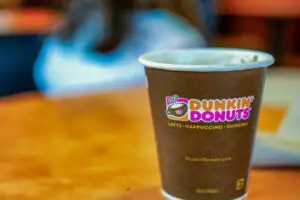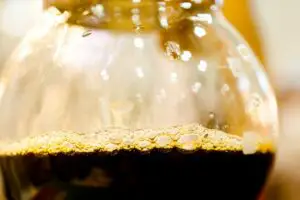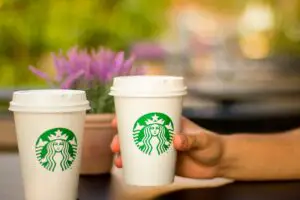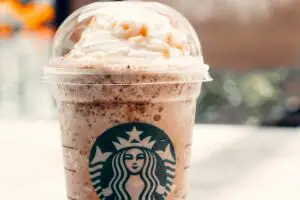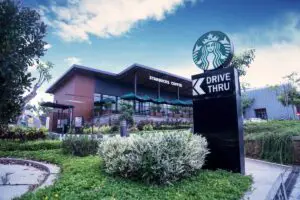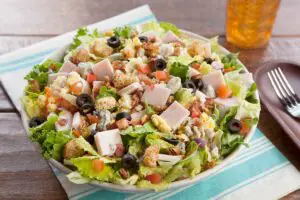*This post may contain affiliate links. As an Amazon Associate we earn from qualifying purchases.
Admit it, there’s just something about that siren on the Starbucks logo – the way she calls to you like an irresistible caffeine goddess, luring you towards that heavenly smelling store.
Before you know it, you’ve forked over your hard-earned cash in exchange for a delicious, customized beverage, and you find yourself wondering, “How did I become so addicted to Starbucks?”
Fear not, my fellow coffee lovers, for in this article, we will delve into the depths of our obsession and uncover the various factors behind our Starbucks addiction.
From the magic of branding, to the science behind caffeine addiction, we’ll take a look at how Starbucks manages to keep us coming back for more, day after day, and year after year. After all, time is ticking until that next limited edition drink hits the stores, so let’s get started exploring the irresistible allure of Starbucks!
The Magic of Starbucks Branding
Analysis of Starbucks logo and store design
Have you ever noticed how the Starbucks stores have similar design elements despite being potentially thousands of miles apart? This is no coincidence. Heck, I recently went on a cruise that stopped in Ensenada Mexico a few months ago and the Starbucks in Mexico even looked like the ones in the US!
Starbucks uses visual consistency to build brand familiarity, providing customers with comfort and familiarity in any location, no matter where they lay their coffee-loving heads at night.
Whether it’s the unmistakable green siren, the penchant for earthy colors, or the overarching spirit of coziness, Starbucks makes its mark on the world through its distinct design.
Emotional appeal and attachment to the brand
Beyond the visuals, Starbucks focuses heavily on fostering an emotional connection with its customers. Think about it: have you ever seen someone walk through the door of a Starbucks without a smile on their face?
I know I can’t remember a time when I haven’t practically skipped in with glee. Starbucks has managed to create an environment that feels like a warm hug, full of friendly faces and bursting with delicious scents, making you feel right at home no matter what the world beyond the store walls is throwing at you.
And as a mother of three (ages 5, 8 and 12), I can assure you that escaping into the comforting arms of Starbucks for even the briefest of moments often feels like a much-needed vacation!
Another vital factor in our Starbucks addiction? Social media’s powerful impact! Have you ever perused your Instagram feed without stumbling upon a stunning shot of someone’s perfectly crafted Starbucks beverage?
Of course not.
Our society thrives on that instant satisfaction we receive from sharing our Starbucks moments, and Starbucks’ social media presence only adds to this craving. From teasing us with seasonal concoctions to featuring mouth-watering images of classic drinks, Starbucks’ marketing efforts are there to pique our interest and keep us returning for more.
Creation of a “third place” concept
It’s not just the coffee, folks! Starbucks has been incredibly successful in creating what they call the “third place” concept, making their cafes the ultimate spot for anyone who needs a break from the ever-aloof realms of “home” and “work.”
In this beautiful, caffeine-scented haven, we can connect with friends or simply find respite from the chaos around us. And after a long day of wrangling kids and juggling schedules, this “third place” feels like an oasis in a barren, wifi-less desert.
The Science Behind Starbucks: Understanding Caffeine Addiction
Explanation of caffeine as a psychoactive substance
Sure, Starbucks provides a cozy environment that we can’t help but associate with warm (literally) feelings, but let’s not forget the scientific side of our addiction! Caffeine, our beloved friend and savior in all things sleep deprivation, is a psychoactive substance, meaning it can alter our perception and mood.
While we sip on that delicious latte, our brain is thankfully being stimulated to keep us awake, focused, and ready to face whatever comes our way (or at least ready to face a dozen conference calls).
How caffeine affects the brain and creates addiction
As caffeine enters our system, it blocks the action of a neurotransmitter called adenosine, which would usually cause us to feel sleepy. Additionally, caffeine increases the production of certain feel-good hormones like serotonin and dopamine, which leads to that much sought-after pleasure and temporary improved mood.
Now, is it any wonder why we just can’t resist that delicious cup of cappuccino?
Starbucks’ specialty drinks and their high caffeine content
While coffee is a beloved staple in many households (including mine- even though my 8-year-old prefers hot chocolate), Starbucks has truly revolutionized the caffeinated beverage game with their extensive menu of specialty drinks.
From iced caramel macchiatos to decadent mochas oozing with chocolatey goodness, Starbucks ensures there’s a little something for everyone. And let’s just say, our brains rejoice over the extra caffeine kick and the tantalizing variety that comes with it.
Role of sugar in enhancing the addictive properties of caffeine
When it comes to Starbucks’ specialty drinks, let’s not sugar-coat it: many come with a hefty dose of sweetness. That added sugar can further entice our brains to crave more, as it only amplifies that pleasurable sensation we experience when sipping on a cup of coffee.
It’s a perfect combo: the caffeine keeps us coming back for the pick-me-up, and the sugar keeps us hooked with its delicious flavor (and no, I don’t even want to count the calories).
The Starbucks Menu: Variety and Customization
Offering a vast selection of drinks to cater to different preferences
One thing that keeps customers loyal to the brand is the seemingly endless variety of drinks that Starbucks offers. Whether you’re a die-hard coffee fanatic, a tea devotee, or a frappuccino fiend, there’s something on the menu for you.
Furthermore, Starbucks is always adding trendy new creations like cold brew or nitro coffee, keeping things fresh and exciting for their customers.
Starbucks’ ability to accommodate dietary restrictions and preferences
With a growing number of consumers adopting plant-based diets or have special dietary needs, Starbucks has made efforts to provide options for everyone. They now offer a variety of milk alternatives, like almond, soy, and oat milk, along with options like “skinny” drinks and sugar-free syrups.
These accommodations make it easier for customers to justify their Starbucks habit as a personal treat that doesn’t compromise their health or lifestyle choices.
Another major factor in the addiction of Starbucks is their seasonal menu offerings. Can you imagine an autumn without the Pumpkin Spice Latte or a winter without the Peppermint Mocha?
These limited-time offerings create a sense of urgency for customers to get their hands on these favorites before they’re gone for another year. This clever marketing tactic keeps patrons coming back for more, fueling their addiction.
The influence of personalized customer service on addiction
Let’s not forget the power of a personalized touch! Starbucks’ commitment to remembering customers’ names and their go-to orders can be incredibly appealing. It makes customers feel valued and recognized, strengthening their connection to the brand and reinforcing loyalty.
This emotional bond further perpetuates addiction, as customers find comfort in the familiarity of a Starbucks interaction.
The Allure of Starbucks’ Rewards Program
Overview of the Starbucks Rewards Program
The Starbucks Rewards program is a major driver of brand loyalty and addiction. Customers earn stars for every dollar spent, which can be redeemed for free drinks and food items.
This gamified system turns everyday coffee purchases into a potentially rewarding experience, encouraging frequent visits.
How the rewards system encourages customer loyalty and repeat visits
By incentivizing customers to make more purchases through the rewards program, Starbucks keeps them engaged and committed to the brand.
Customers often feel a sense of accomplishment when they reach a new reward status, reinforcing their attachment to Starbucks and prompting repeat visits.
Exclusive perks and offers for members
Starbucks Rewards members are treated with exclusive offers, such as double star days, members-only drinks, and birthday treats. This creates a feeling of exclusivity and VIP treatment, further solidifying the brand’s addictive appeal.
Gamification of the rewards program and its impact on addiction
The gamification of Starbucks’ rewards program adds an element of fun to the customer experience. Customers enjoy tracking their progress, seeing their stars add up, and the anticipation of earning that “free” drink.
This ultimately encourages more frequent visits and deepens addiction to the brand.
The Role of Price in Starbucks Addiction
Though Starbucks is known for its somewhat pricey drinks, customers often justify the expense as a necessary luxury or a well-deserved treat. The perception of Starbucks as a higher-end coffee choice further drives addiction, as customers associate the brand with quality and indulgence.
The perception of luxury and exclusivity associated with the brand
By attaching a higher price tag to their products, Starbucks positions itself as a premium brand. Customers often feel a sense of accomplishment or status when they can afford to partake in this indulgence, further attracting them to the brand.
How customers rationalize the price paid for Starbucks products
Many Starbucks addicts rationalize the expense by considering the customization options, convenience, and consistent quality they receive.
In this context, the price paid for their favorite drink becomes a justifiable investment for the experience.
Implications of Starbucks’ price on consumer behavior
Some customers may visit Starbucks less frequently due to the expense, turning their visits into special occasions and treats. This can, in turn, create a heightened sense of enjoyment and craving, making the visits even more addictive.
The Impact of Starbucks Social Responsibility Practices
Overview of Starbucks’ commitment to ethical and sustainable practices
Starbucks is well-known for its commitment to ethical business practices, sourcing fair-trade coffee, and implementing environmentally friendly policies. This reputation adds to its allure, as customers appreciate supporting a brand that values social responsibility.
When customers feel that a brand aligns with their values and contributes positively to society, they are more likely to be loyal and promote it to others. This connection to Starbucks’ efforts in social responsibility creates another layer of addiction, as customers take pride in being part of a brand that strives to make a positive impact.
Fair-trade coffee sourcing and environmental initiatives
Starbucks’ fair-trade coffee sourcing ensures that farmers receive fair prices for their products, promoting ethical practices in the coffee industry. Additionally, Starbucks has taken significant steps towards sustainability, such as reducing plastic waste and investing in renewable energy.
Customers who are passionate about these issues often feel a strong connection to the brand and are more likely to maintain their Starbucks addiction.
As consumers become more aware of the importance of environmental and ethical practices, brands that prioritize these values gain a competitive edge. In the case of Starbucks, this perception of social consciousness adds to the overall appeal of the brand, further fueling addiction.
Starbucks and Pop Culture: The Celebrity Effect
How celebrities and influencers contribute to Starbucks addiction
Celebrities and influencers are often spotted with Starbucks in hand, creating an association between the brand and success or glamour.
This celebrity endorsement, whether intentional or not, can contribute to the addictive allure of Starbucks by amplifying its perceived value and status.
Pop culture references to Starbucks in music, TV shows, and movies
The prevalence of Starbucks in pop culture, from song lyrics to TV shows and movies, adds to the brand’s ubiquity and enhances its cultural clout. These references make Starbucks seem like an essential part of daily life, further fueling addiction.
Starbucks collaborations with artists and designers
Collaborations between Starbucks and popular artists or designers can boost the brand’s appeal, creating a sense of excitement and exclusivity around limited-edition products. This hype can contribute to Starbucks addiction, as customers are enticed to indulge in the unique offerings.
Much like celebrities, social media influencers play a role in promoting Starbucks addiction.
By sharing their Starbucks experiences on platforms like Instagram or Twitter, influencers create a sense of community and FOMO among their followers, sparking a desire to partake in the trend.
The Psychological Aspect of Starbucks Addiction
The role of habituation and rituals in addiction
For many people, visiting Starbucks becomes a daily ritual or habit, contributing to their addiction.
Humans derive comfort and enjoyment from familiar routines, making it difficult to break away from these established habits.
Starbucks-induced FOMO (Fear of Missing Out)
As mentioned earlier, Starbucks’ limited-time offers and seasonal drinks can induce a sense of FOMO among customers, leading them to indulge out of fear that they may miss out on something special.
This emotional response can contribute to the addictive nature of the brand.
The power of Starbucks to induce happiness and stress relief
Many people associate Starbucks with positive emotions and stress relief, making the brand an irresistible coping mechanism during trying times.
This emotional connection creates a powerful addiction, as customers seek out that familiar comfort and momentary escape from their daily stressors.
A sense of community and belonging created by Starbucks
Starbucks fosters a sense of community, both in-store with their friendly baristas and through online platforms like social media.
By creating a sense of belonging and camaraderie among customers, Starbucks becomes more than just a coffee shop – it’s a part of their identity, further perpetuating addiction.
Conclusion: Can Starbucks Addiction Be Managed?
As we’ve explored throughout this article, there are numerous factors driving Starbucks addiction. By recognizing these driving forces, individuals struggling with this addiction can better understand their personal triggers and take steps to manage or counteract them.
To manage Starbucks addiction, individuals can implement practical strategies such as setting a budget for coffee spending, exploring alternative venues for socializing and studying, or trying their hand at making their favorite Starbucks drinks at home.
By exploring other coffee shops, local cafes, or even brewing at home, individuals can begin to break free from the hypnotic allure of Starbucks. Though Starbucks addiction may remain a cultural phenomenon, being self-aware and proactive can help individuals regain control over their habits and decisions.
In conclusion, Starbucks addiction is more than just a caffeine fix – it is a multifaceted experience fueled by branding, sensory pleasures, emotional connections, and cultural influence. As with any addiction, self-awareness and moderation are crucial in finding balance and ensuring that our beloved Starbucks visits remain a source of joy rather than a means to an unhealthy dependence.

